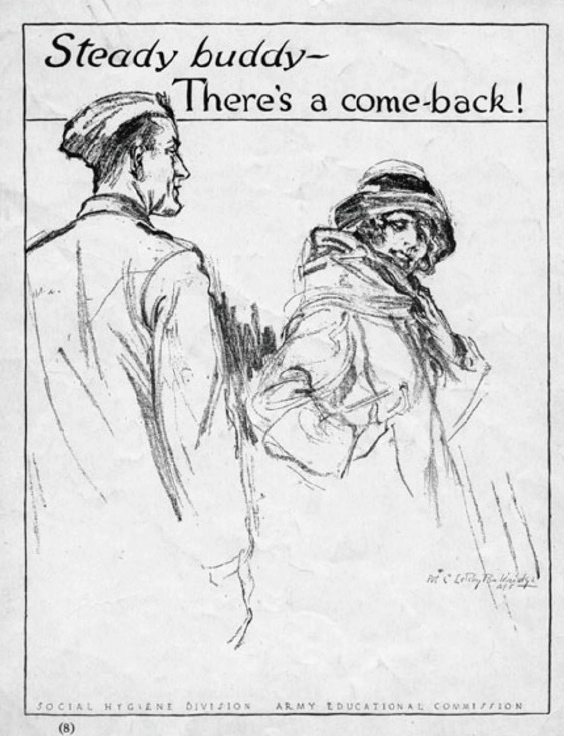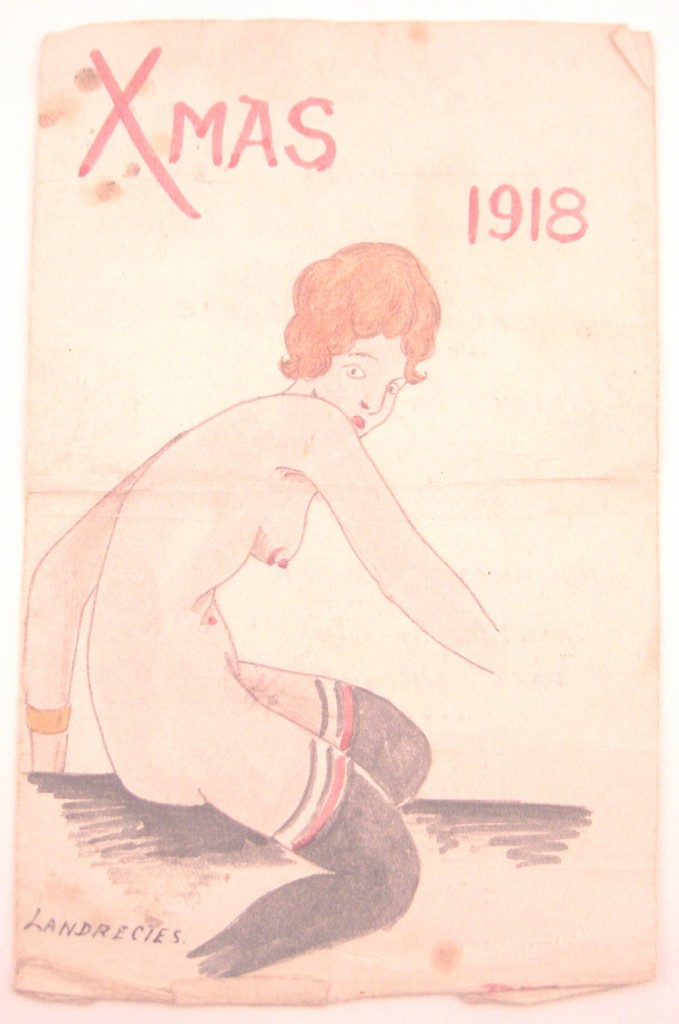In 1918, the final year of the First World War, over 100 women were convicted for infecting a member of His Majesty’s (HM) armed forces with venereal disease (VD) in England under the controversial Regulation 40D of the Defence of the Realm Act (DORA). Young Lucy Adams from Wakefield was one such woman. She was arrested following a brief affair with an unnamed soldier, and faced a public trial. During the trial, she would have heard the details of her disease retold by the medical practitioners to an all-male court room before being sentenced by the magistrate to a six-month imprisonment, with hard labour. Adams, who was married at the time, protested, claiming that she did not know that she was suffering from the disease. As reported by the Wakefield Express on 7 September 1918, the magistrate told her in his sentencing remarks that when her term was up, he hoped that she would become a proper citizen – highlighting her failure not only as a wife, but also as a citizen.

The First World War is often viewed as a catalyst for women’s rights as women gained better access to the labour market and the right to vote shortly after. Simultaneously, the fear of prostitution and female promiscuity peaked during the war. As a response, the War Office attempted to control women’s lives in a number of ways under DORA, such as restricting drinking, imposing curfews in some areas, and banning women suspected of prostitution from the vicinity of military bases. This post offers some reflection on the trials of women accused of infecting soldiers with VD and on their reporting in the press, as scholars rarely acknowledge or discuss these marginalised women in relation to the First World War.
While researching the legal history of DORA and the regulation of sexuality during the war more broadly, I came across a series of newspaper reports on trials against women for the transmission of VD under DORA. Intentional or reckless transmission of VD is a criminal offence today but it was not so in 1918. Perhaps the most striking aspect of these reports is the profound and devastating impact these trials would have had on individual women, and how this was rarely acknowledged in the reports. The trials of women like Lucy Adams under Regulation 40D were highly public and they were always reported in the local and sometimes national press. The names, occupations, and addresses of the accused girls were made public, while the soldiers, who were bringing the charge, remained anonymous. Doctors’ testimonies and the details of the defendant’s medical status and history were central to the trials and sentencing remarks.
Regulation 40D was only in force for a short period of time, from March 1918 to November 1918, yet, it was significant and hugely controversial. The sexual encounters between local girls and soldiers that might have only been considered undesirable before conflict, were effectively criminalised during the war in the name of national security. The War Office and Home Office archives show that 40D was passed under pressure from the Canadian and other Dominion governments who were worried about rising rates of VD and the safety of their troops. The army officials were concerned that girls, allegedly gripped by the khaki fever, were throwing themselves at the troops passing through London and South East England. Women’ rights organisations vehemently opposed it and the majority of Parliament never supported the Regulation, yet, the War Office insisted it was necessary for the protection of the troops and national security. While VD was a significant problem in the army and around 400,000 cases of VD were treated during the war, the Regulation was ineffective in tackling VD as it only targeted women, leaving men, the other half of the carriers, with no penalty. The dozens of civil society organisations led by the Association for Moral and Social Hygiene (AMSH) rallied against the Regulation denouncing it as an idiotic move in a battle against VD, and even MPs accused the War Office of bringing back the 19th century Contagious Diseases Acts (CDAs 1864-1869). The CDAs 1864-1869 had been applied in selected garrisons and port towns, requiring women suspected of prostitution to submit to an examination, which led to the creation of the first records of suspected prostitutes in those towns. They were repealed, following a nationwide campaign led by Josephine Butler, the legacy of whom was carried on by the AMSH. Both CDAs and 40D were enacted on the premise of national security, but unlike CDAs, 40D applied across the country to all women regardless of whether they were suspected of prostitution.
Regulation 40D allowed for a woman charged with an offence to be remanded for a week for the purpose of medical examination in order to ascertain whether she was suffering from VD – solely based on an accusation by a soldier. She then had to face a public and humiliating trial, in most cases without legal representation, and as the only woman in the room. The papers often described the women on trial in great detail: her demeanour, past behaviour, and her distress at sentencing. While some papers were clearly sympathetic to the plight of women facing the outrageous charge, the newspaper clips were also warning examples to others highlighting the threat imposed by the ‘diseased and immoral’ women to the communities and the army that was weakened when soldiers fell ill.
If the woman in the dock was married, the papers were sure to mention this regardless of whether the charge was brought by the husband or a lover. During the First World War, married women received a separation allowance while their husbands were at war. If a married woman was convicted of a crime, they lost the separation allowance. If a woman married to a serviceman was convicted under 40D, the press would normally note that they would be losing their separation allowance as if it were a further punishment. The trials of married women are particularly interesting and it could be said that in the absence of local men, the courts were punishing the unfaithful wife for her failures as a wife and as a citizen, as evidenced by the case of Lucy Adams discussed in the beginning.

While the fear over prostitution and associated VD was one of the key reasons behind the regulation, it would be misleading to say all women tried under Regulation 40D were known to be working as prostitutes. Rather, the women held varied working class professions such as domestic servants and dress makers. The majority of the women on trial were also very young, some as young as fifteen. However, age did not seem to soften sentencing as many girls under the age of eighteen were given the maximum of six months with hard labour.
The newspaper stories, though often brief, were also sensational when it came to reporting on VD, including details of women’s private sexual encounters and medical records. The doctors who had examined the woman and/or the soldier would testify in court and describe their findings on the severity of the infection and stage it had progressed to in the trial. They also explained when the disease had been most contagious, leaving the readers with knowledge of the defendant’s past sexual history. These testimonies and doctor’s verdict would then be reprinted in the press.
The medical testimonies took centre stage at the trials because the only way for a woman to disprove the charge was to be examined for signs of VD and found not to be suffering from it. In the majority of the cases, charges were, in fact, dropped when the examination found no evidence of VD. Some women refused to be examined by the prison doctor and opted for a private one due to distrust of prison officials, or requested a re-examination by a private doctor if the prison doctor’s findings were inconclusive. Some women, mainly those working as prostitutes, preempted the accusations and gained certificates of health from their doctors to show that they were not suffering from VD. These certificates could then be shown to potential clients, as well as to the police. The magistrates were skeptical of the certificates, yet, in a few cases, a woman was released upon producing the document. The certificates and medical testimonies, therefore, became currency for women whose liberty was at stake.
The cases and their reporting can also be seen as a prism through which femininity was assessed and reassessed as evidenced by the case of Alice Cowley from Stony Stratford. Even if she was released after receiving a clean bill of health from the doctor, according to the Buck’s Standard on 11 May 1918, the magistrate called her a wicked and sinful woman, who ‘ought to be ashamed of herself’. In some of these cases, the perceived past sins of the women on trial and a mere suspicion of VD was enough to render them guilty in the eyes of the magistrates, and to subject their private lives to public scrutiny.
While 40D was an emergency legislation and has to be understood within the context of war and the rhetoric of national security, it ultimately reveals how the state viewed women’s bodies as dangerous and as a security threat. Specifically, Regulation 40D and the related cases are closely linked to the controlling of morals and the fear over young women’s sexuality, as demonstrated by the fact that nearly all the women were aged sixteen to twenty-four. The trials and related newspaper reporting became an extension of that control by judging female sexual behaviour and by publicly naming and shaming women who had engaged in extra-marital sex.
 Laura Lammasniemi is a teaching fellow at SOAS (School of Law). She researches the regulation of gender, class, and sexuality from a mostly historical perspective. She is also a PhD candidate at Birkbeck College (School of Law). Her thesis focuses on the first legal measures against white slavery/trafficking in women in England, 1880s-1920s, and the construction of victimhood and criminality within these measures.
Laura Lammasniemi is a teaching fellow at SOAS (School of Law). She researches the regulation of gender, class, and sexuality from a mostly historical perspective. She is also a PhD candidate at Birkbeck College (School of Law). Her thesis focuses on the first legal measures against white slavery/trafficking in women in England, 1880s-1920s, and the construction of victimhood and criminality within these measures.

NOTCHES: (re)marks on the history of sexuality is licensed under a Creative Commons Attribution-NonCommercial-NoDerivatives 4.0 International License.
Based on a work at www.notchesblog.com.
For permission to publish any NOTCHES post in whole or in part please contact the editors at NotchesBlog@gmail.com





2 Comments